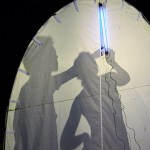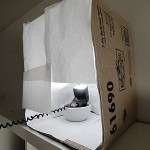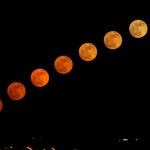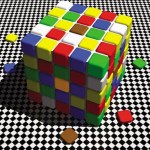Light
The internet sure can bring some awesome stuff. Chad at Uncertain Principles has a great post about the vision of elves. He refers to a part of The Two Towers where Legolas can count the number of riders of Rohan from a great distance.
Not only is the post great, make sure you read the comments also. Very impressive discussion.
Another electric motorcycle post. (Here is the post on the wind-recharged drag racing motorcycle) This new one is a solar powered motorcycle. The site claims that the bike can go 50 miles on a full charge (from Gas2.org). This is easily possible, but how long would it take to charge with normal solar panels? Here is an image of the bike.
Questions to be answered: How much energy would the bike need to go 50 miles? How much power (average) could you expect to get from the solar panels? And...how long would it take to charge this sucker. I am sure you can store enough energy in a…
There are a couple of things I should probably not talk about. One of them is photons. But no matter what you think about photons you will probably agree that this is not a very good description of electromagnetic radiation. (from comos4kids.com)
Structure of Energy:All EM energy waves travel at the speed of light when in a vacuum. No matter what their frequency or wavelength, they always move at the same speed. Some properties of waves, such as diffraction and interference, are also seen in EM radiation. Scientists have figured out that there are tiny particles in these waves. The…
Step 1. Locate a suitable patch of forest, field, or desert.
Step 2. Wait for a warm, moonless summer night.
Step 3. Using a long extension cord, plug in a blacklight. Or even better, a mercury-vapor lamp.
Step 4. Sit back and watch your prey arrive.*
*disclaimer. This technique works generally for most entomologists, but if your needs are more specific, you will wish to employ more specialized methods. Forensic entomologists prefer roadkill, for example.
An anonymous commenter asked if I could explain the white box I sometimes use for insect studio shots.
Here it is:
There's not much to it. It's an old cardboard box- this one once held toilet paper, I think- with white printer paper taped along the inside. The strobe is placed inside the box. When the strobe fires, the box is filled with a lovely diffuse white light.
White boxes only take a few minutes to assemble, and I'll often make one on location if I need to. Natural substrates like leaves and rocks can be added to the box so that it approximates a field setting. The whole thing…
I am not sure if First Excited State posted this as a blog entry, but it was mentioned on twitter. Question: why are sparks blue? My first gut response was that this is the blackbody color. Wrong for several reasons. The short answer is that sparks are blue because of the colors given off from nitrogen and oxygen when they are excited.
In order to make this post longer than necessary, let me say something about blackbodies. A blackbody is an object that emits radiation due only to it's temperature. Since it does not reflect anything, it looks black at room temperatures. You can make a…
Light is an ephemeral but powerful artistic medium. This commercial for the Belgian energy company Electrabel captures the whimsical charm of fireflies on a warm summer night:
You can view a stunning higher-res version of this video here, with slightly different music. There is also a making-of video with scenes of the film shoot.
Thanks to Rhett for finding this one!
Compare these two images, both of the same swarm of mating ants:
What's the difference?
The lighting, of course. In the first image I stood facing the rising sun so that the insects' translucent wings glowed, while in the second I moved to shoot the swarm from another angle, the sun hitting them from the side. A much plainer result, to my eye.
Managing light is the most important aspect of photographic composition. Entire books (as well as some fantastic blogs) have been written on the subject. I can't compete with that level of detail in a short blog post, so let me instead distill the…
Quantum mechanics is not my area of expertise. Really, I have no area of expertise. However, I think it is time to bring the whole photon thing back up. Yes, I know I was a little harsh before. Maybe I should start over.
First, models. Yes models. I think science is all about models. Scientists build models that attempt to agree with observations. These models could be mathematical, physical, conceptual or numerical (like a computer program). For example, take Newton's Law of gravity (which isn't really a law). It says that the gravitational force between two objects has the…
[In part I of this post](http://scienceblogs.com/dotphysics/2008/11/interaction-between-light-an…), I struggled to show that a particle in an infinite well can only exist at certain energies. If you try to put a particle with more than one energy, the probability oscillates at a frequency (E2 - E1)/h. So, what is next? Well I think I am ready to attack the photon.
According to the ultimate source of truthiness (wikipedia), [the photon is the elementary particle responsible for the electromagnetic interaction](http://en.wikipedia.org/wiki/Photon). In general, the photon is view as the…
One of the fundamental aspects of physics is the study of light and how that interacts with matter. I have been putting off this post - mainly because I am not a quantum mechanic (I am a classical mechanic). There are lots of things that could be done in this post, but I am going to try and keep it limited (and maybe come back to the interesting points later). Also, most of my posts are aimed at the intro-college level or advanced high school level. This will be a little higher. If you are in high school, there is still a lot of stuff for you here.
Let me summarize where I am going to…
My kids like books. Especially when they are going to bed. I let my daughter pick a book and she picked "Clam-I-am. All About the BEACH" by Trish Rabe. It is nice, it rhymes. The pictures are pretty. Then I get to this page:

So, the ocean is blue because of the sky? How do you get green oceans? How about brown (I live in Louisiana, trust me - the gulf of Mexico can be brown)? What about when you are underwater, everything looks blue. The best answer to why the ocean is blue is that that is what color does…
The firm Site Specific Design, creates furniture inspired by arthropods (particularly chilopoda), mollusks, and the other critters that live under decaying leaf matter. Creative Director, Rui Docouto, explained that as a child he was fascinated with "bugs." "The goal with the bug-lamps was to give them a feeling of movement as though they were alive and in the process of movement, as they still are in the artist/designers memory." Check out their elegant, creepy-crawly furniture which is sure to be a huge hit within the fabulously wealthy entomologist market.
Formiga
Nymph
more below the…
This has been all over my inbox since the press release came out yesterday; it's been on slashdot (thanks Brian), it's been at space.com, and there's a mediocre writeup on Universe Today. What's the big news? Black Holes don't destroy information after all!
What is this whole information thing, anyway? Take a look at all the normal stuff in the Universe: photons, protons, neutrons, and electrons, for example. They have lots of different properties each. They move around one another, they get bound and unbound from one another, they exert forces on one another, etc. They're aware of one…
Warning: Crazy talk ahead. Some of you may remember that I wrote about inflation and why its alternatives fail awhile back. Apparently, Louise Riofrio didn't get the memo. When there's misinformation about cosmology out there, it's up to me to set the record straight. (And I am not alone.) Let me first remind you about one of the alternatives to inflation I debunked last month:
Add defects and vary the Speed of Light. This one’s out. Why? Because we would see defects in the Cosmic Microwave Background, and we don’t. The constancy of the speed of light is highly supported by experiments, but…
There's a graduate student that I'm sort-of mentoring/working with at Arizona, named Xiaoying Xu (hi Xiao!). She's bright and curious, and she asks some very good questions. She asked me one yesterday that's pretty tough to wrap your head around:
How do I explain to someone why light doesn't age?
Well, here on Earth, time progresses at a certain speed. That is, if I measure how many seconds tick by as the Earth revolves once around the Sun, I'll get 31,556,926 seconds. (31,558,150 if I'm measuring a sidereal year.)
But let's say in the course of that year, I put you on a rocket ship, and…
Alright, startswithabang-ers, Ben, my most avid commenter, saw me online while I was eating breakfast this morning, and pointed me to this new press release. Now, before you get started clicking on everything, the guy who the release is about is Brian Gaensler, who's a really nice guy, lives in Australia, whom I met at the AAS (American Astronomical Society) meeting in Austin, TX last month. Bryan's also brilliant.
Basically, what he did was he said, "well, we know what the rough density of hot gas in our galaxy is, and we can measure the timing of these pulsars to extraordinary accuracy."…
The closest you're going to get from me on Valentine's Day is something red, dear readers. As the Moon is now a waxing gibbous and will be for the next week, it will brighten the sky for the majority of the night. But before sunrise, it will dip below the horizon and set. The funny thing is, if you've ever watched this (or watched a waning gibbous rise), you'll notice it changes color! In fact, this composite photo shows you what I'm talking about:
So the Moon, although white once it gets high up into the sky, appears yellow, orange, or even red when it's close to the horizon. I got a…
Starts With A Bang! is off to a great start; each the past three days we have topped the 100 visitor mark, bringing our total number of unique visitors up to 1,413! I'm going to attempt to start a new tradition here of making a weekend post on a topic that I just find neat, and share it with you. This first Weekend Diversion is an optical illusion about color. Take a look at the image below:
Looks like a cube with a bunch of different colors on it. Now do the following:
Look at the top face of the cube, and tell me what color the tile in the middle of that face is.
Look at the near face,…







